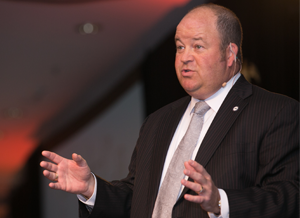
Community Banks: You Don’t Have to Get Left Behind
 Heartland Bank has just 11 offices in central Ohio. The holding company, Heartland BancCorp near Columbus, Ohio, has $600 million in assets. The company is not traded on any public exchange and traces its roots back more than 100 years in agricultural lending.
Heartland Bank has just 11 offices in central Ohio. The holding company, Heartland BancCorp near Columbus, Ohio, has $600 million in assets. The company is not traded on any public exchange and traces its roots back more than 100 years in agricultural lending.
But that doesn’t mean Heartland is behind the curve when it comes to technology. In fact, Heartland developed its own mobile banking applications, has person-to-person bill pay, mobile bill pay, surcharge-free ATMs across the nation searchable on your smartphone, and a host of other digital products designed to serve customers’ needs.
“The technology is here and it’s affordable,’’ said Heartland Chairman, President and CEO G. Scott McComb at Bank Director’s Growth Conference in New Orleans recently. More than 120 bank directors and officers attended the two day conference May 1-2, which focused on growing the bank organically, mostly through technology, data-based marketing and sales, and niche or specialized lending.
Bank of America and JPMorgan Chase & Co. may have more resources to develop technological solutions and service them, but community banks increasingly have options as well. Technology providers such as Deluxe Corp., CSI, CDW, StrategyCorps and MoneyDesktop described how banks well below the $50-billion asset range can still gain access to sophisticated technology. For instance, community banks can now analyze credit agency data to find out which of their customers are shopping for an auto loan, and then send customized marketing materials to those customers.
Banks can help customers budget and manage their entire financial lives with online banking tools, which also give banks a trove of potential marketing data on them. Banks can generate fee income by sending coupons to their customers based on the geo-location given by their smartphones. Analytical tools also allow banks to track what customers are saying about them on social media.
First Financial Bankshares, a $5.8-billion asset bank holding company in Abilene, Texas, allows customers to take pictures of their bills with their smartphones, send the pictures to First Financial Bank, and the bank will pay their bills. Similar products are being marketed to banks much smaller than First Financial.
Jeff Casey, a senior vice president at the bank, said mobile customers use three times the number of products and services of other bank customers and are 2.5 times more likely to stay with the bank than other customers. He advised banks to think five or 10 years into the future and plan for the fact that technology will be radically different by then. A full 25 percent of First Financial’s mobile banking customers currently don’t use a laptop or desktop to do their banking. “You have to get rid of this idea that you’re always going to have online [desktop or laptop] banking,’’ he said.
This fact is creating challenges for banks trying to decide where to invest. Deluxe Corp.’ Vice President Scott Wallace cautioned banks not to try to be all things to all people. The type of customers you want and the delivery mechanisms they need will determine the technology and tools to buy.
McComb, Heartland Bank’s CEO, said that community banks actually have an advantage when it comes to data and technology. Community banks are nimble because of their size and can make decisions quickly based on their customers’ needs. They know their customers better than bigger banks do. They are the American colonists fighting the English in a war against the big banks. They can be first to market, not laggards when it comes to meeting their customers’ needs. And that could mean the difference between being relevant or not at all.


